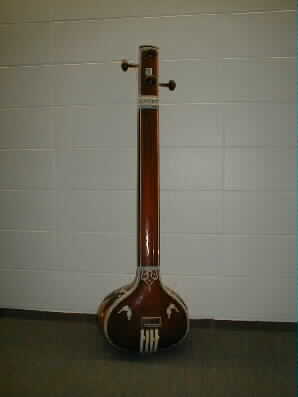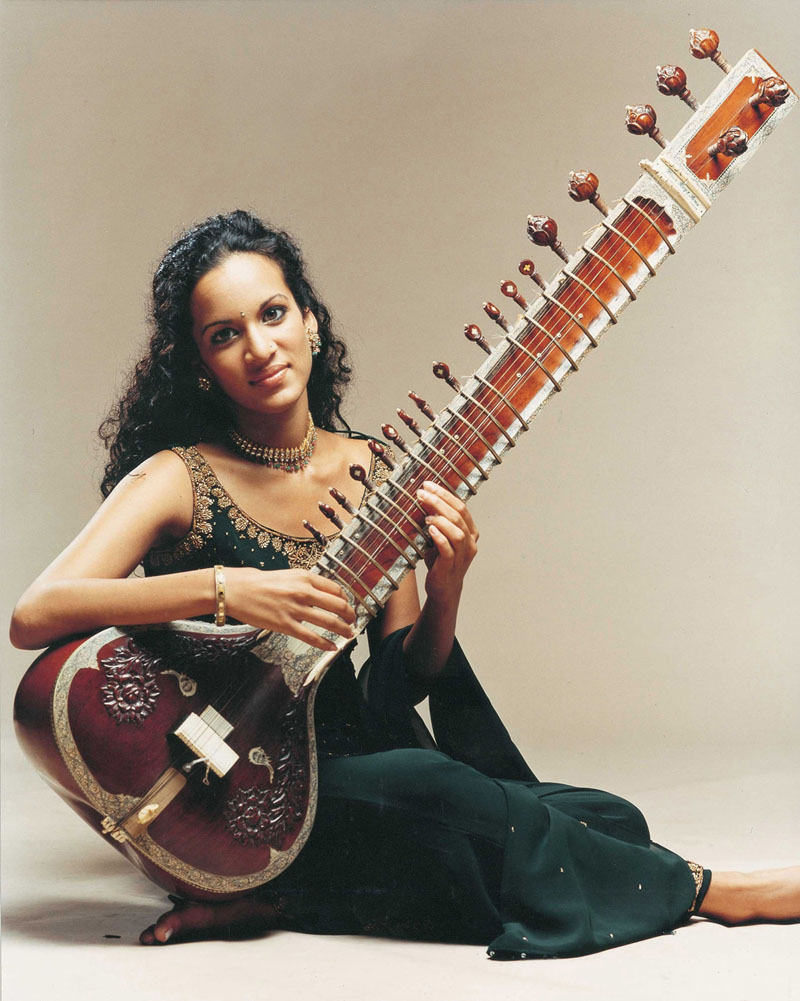


At the next link, you can hear the sound of the tambura.

Here is a photo of Ravi Shankar’s daughter Anoushka playing one of the beautiful custom-made sitars crafted by Nodu C. Mullick. Notice a few things about this instrument. First, the frets are curved. This allows for you to play sliding notes on one string, merely by pulling the string over the fret. Underneath the frets and running almost the full length of the neck are 13 sympathetic resonating strings, which are tuned to the notes of the raga being played. When the instrument is tuned properly and you play a note wth a fret, you can watch the appropriate resonating string vibrate as if by magic. These strings are tuned by the pegs running along the top of the neck.
There are four playing strings plus three more that are clustered together at the edge of the neck closest to the player. These are the chikari strings which are strummed as a group to give rhythmic punctuation. Also, notice that this instrument DOES NOT have a resonating gourd at the end of the neck like her father's instrument.
When Ravi Shankar begins an improvisation he will often slide the nail of his little finger over the sympathetic strings. This is the way that sounds.
Then the alap section of the piece begins. It a long slow improvisation that often goes to the lowest register first and then moves up. Here is the low part of a recording Shankar did in England in 1956. If you note the time, you can hear the effect of the resonating strings very markedly between 40 and 50 seconds.
After this, we arrive at the section known as jor. It is distinguished by rhythmic striking of the chikari strings which you will clearly hear in the next example.
The gat begins where the rhythm instrument enters. Here it is the tabla, which consists of two tuned drums, the tabla and the bayan. It is in a rhythmic cycle of 16 known as Teental. Interestingly, the drums enter on beat 15 and beat one (or sum as the Indians call it) is silent. There is a tone every sixteen beats so you won’t get lost. Listen!
You can hear by the rhythms of the soloist and the drums how complicated it can get. This is a simple rhythmic cycle. Cycles of 5 and 7 beats are not uncommon as is one cycle of 6 ˝ beats.
Indian music is amazing, but it takes much study. The oft-quoted statistic about Ravi Shankar is that he practiced 14 hours a day for seven years.
Please check back at the section for D.O.’s blog in the Poetry Plaza, because it will soon contain a section about meeting Shankar.
If you need to leave, Go to initial page of site.
If you are interested in advertising a music-related business in the pages of the classroom, please send us an e-mail regarding rates by clicking here.